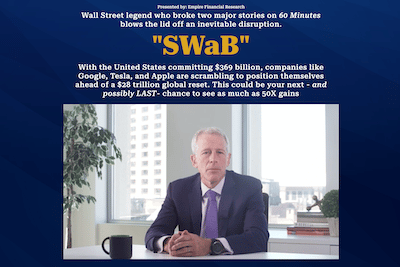Nomi Prins is out with a new teaser about what she’s calling “Liquid Energy,” a tech she believes is “the #1 solution for the $130 trillion transition to clean, renewable energy.”
And according to Prins, the “$4 company” behind Liquid Energy could not only “derail Tesla,” which she suggests is betting big on large-scale energy storage, but “make investors a huge return” during the so-called “energy transition” she sees unfolding.
“Liquid Energy runs longer… lasts longer… is better for the environment… is cheaper to run… and I truly believe it is the #1 solution for the $130 trillion transition to clean, renewable energy.”
[…]
“… investing in this tiny $4 company that could derail Tesla. And make investors a huge return during this historic $130 trillion energy transition.”
Source: https://secure.rogueeconomics.com/?cid=MKT675349&eid=MKT677391&assetId=AST262052&page=2
Long story short, Prins is pitching a newsletter called Distortion Report from Rogue Economics, which costs $49 for a 12-month subscription.
And she reveals her pick in a report that members of this service get access to, called “Liquid Energy: The #1 Stock for the $130 Trillion Energy Revolution.”
But if you’re a regular reader, you know the drill…
I looked into Prins’ clues to see what I could find. And in this post, I’ll show you everything I found, including the name and ticker of the company I think she’s teasing.
Breaking Down Nomi Prins’ “$130 Trillion Energy Revolution” Pitch
Nomi Prins’ latest presentation kicks off with a rather unusual demonstration involving powering a small light with a lithium-ion battery on one side of a table and small cups of a “liquid” on the other side (one of which she drank out of to show it’s not toxic).
Shortly thereafter, Prins explained that the liquid she used in the demonstration is water mixed with a second material in a jar she held up, which she never revealed.
And whatever it is, she claims it’s “100% environmentally friendly and safe” and can store energy “up to 94% cheaper than a Tesla lithium-ion battery.”
“It is 100% environmentally friendly and safe.
“In fact, unlike Tesla batteries that are notorious for bursting into flames…
“This liquid is so safe you could use it to extinguish a burning Tesla.
“Non-toxic.
“Environmentally friendly.
“And stores energy up to 94% cheaper than a Tesla lithium-ion battery.
“It’s Tesla’s worst nightmare.
“I call it ‘Liquid Energy.'”
As the presentation continued, Prins argued that, while lithium-ion batteries are “fine” for running small electronics and electric vehicles, Liquid Energy is superior.
“Because little lithium-ion batteries like these are fine for running your TV remote or powering a flashing light… and even powering an electric car…
“When it comes to energy storage on a massive scale? When you’re talking about dealing with huge amounts of stationary power… like what you need to run a home, a city, or even an entire state?
“‘Liquid Energy’ is superior to the lithium-ion battery in every way.”
And throughout the presentation, she (more or less) suggested that Liquid Energy is better than Tesla’s Megapack (a large-scale battery used to store solar and wind energy) because the Megapack uses lithium-ion batteries.
Why does she believe “Liquid Energy” is superior to lithium-ion?
Aside from being environmentally friendly and cheaper, Prins claims that the “open” battery systems that utilize Liquid Energy can be “recharged instantly” because the electrolyte (aka the fluid that holds charge) can be pumped in and out.
“Because instead of a traditional CLOSED battery system like this lithium-ion battery that takes forever to recharge…
“The new OPEN battery system Liquid Energy can be recharged INSTANTLY”
[…]
“That’s because, as the name implies, the battery is OPEN.
“The electrolyte – the fluid that holds charge – can be pumped in and out.”
She also said that these “open batteries” can run (and last) for longer:
“Open batteries run longer.
“10 hours at a time. More than double the 4-hour run time of a Megapack.”
[…]
“Open batteries last longer. A battery can only be charged and discharged so many times. This is called a cycle. Open batteries can be cycled 20,000 times. But you can only cycle a closed battery 2,000 times.
“That gives open batteries a lifespan of up to 30 years versus as little as 5 years for a lithium-ion battery.”
Prins did say that “Liquid Energy batteries” aren’t better in every way because they “can’t deliver a massive amount of energy quickly” and they are “a lot heavier.”
But the main point she made, at least from my perspective, was that this so-called liquid energy battery (aka open battery) could be a better option for large-scale energy storage and could be a big part of the “energy transition” she talked about in the presentation, given that solar and wind are intermittent power sources.
What specific battery is she talking about?
And what company makes it?
Prins didn’t reveal either of those things in the presentation. But I looked into the clues she shared, and based on those, I think I know what she’s teasing.
What “Liquid Energy” Company is Prins Teasing?
Aside from referring to her pick as a “tiny $4 company” and sharing some general hints about the company’s battery, Nomi Prins dropped several other clues.
For example, here are some quotes she shared in the presentation:
“That’s why Forbes says this open battery may be ‘the future of utility-scale energy storage.’
“U.S. Congresswoman Diana DeGette said it’s ‘The key to unlocking the full potential of solar and wind energy… for use around the clock.'”
Upon looking into the above quotes, I found that they were both referring to a type of battery known as a flow battery.
Explaining how these batteries work is beyond me, but the gist is that it’s a large-scale battery that uses two liquids separated by a membrane.
And both of the articles associated with the above two quotes specifically mentioned a flow battery made with a rare earth metal called vanadium. So I started looking into companies that make this type of flow battery, but none of them matched Prins’ clues.
So I kept on digging…
And it was the following two clues that solved it.
First, Prins said in the presentation that five billionaires (Gates, Ma, Bloomberg, Branson, and Bezos) are betting on the company behind the “Liquid Energy” battery:
“Well, Billionaires Bill Gates, Jack Ma, Michael Bloomberg, Richard Branson, and Jeff Bezos are betting this liquid is the battery of the future.”
And second, she dropped the following clue:
“No wonder one CNBC commentator said, ‘you can follow the money… all the investors are smelling it.’
“And that’s why 5 billionaires are betting against Elon Musk…
“And investing in a tiny $4 company that could derail Tesla plans and dominate the future of energy storage.
“Liquid Energy runs longer… lasts longer… is better for the environment… is cheaper to run… and I truly believe it is the #1 solution for the $130 trillion transition to clean, renewable energy.”
The above CNBC quote was taken from this CNBC article, which states that all five of those billionaires invested in a company called ESS, Inc. in November 2019 through a fund called Breakthrough Energy Ventures.
And not only is ESS sitting at around the $4 mark ($4.26) at the time of writing (September 2022), but its ticker (GWH) matches yet another clue Prins shared about her pick being a “3-letter ticker you can buy through your normal brokerage account.”
So, long story short, I think Prins’ “Liquid Energy” stock pick is ESS.
ESS is an Oregon-based company founded in 2011 that “designs, builds and deploys environmentally sustainable, low-cost, iron flow batteries for long-duration commercial and utility-scale energy storage.”
And according to the company website, its technology uses “food-grade, earth-abundant iron, salt, and water for the electrolyte.”
So instead of using rare-earth minerals for its flow batter (like vanadium), my understanding is that it uses iron, which the company says “produces less environmental harm” in materials sourcing (aka mining) and production. And according to the company, not using rare earth minerals is partly what makes the system it’s developed a “more affordable choice.”
I’m not an expert in how this tech works, though, and I’m sure there’s some nuance to consider with all of this, so I recommend doing your own research.
And on that note, you may find the following CNBC video worth a watch if you want a broader view of flow battery technology in general:
I also found several videos about how ESS’ technology works on the company’s website, which you may find helpful if you want to dig deeper into their specific tech.
Recommended: Go here to see my #1 rated stock advisory of 2024
Bottom Line
I have no idea if flow battery technology is the future of large-scale energy storage or not, but I did find learning about this stuff pretty interesting.
And to me, a flow battery that uses iron, which is the most abundant element on earth by mass, does seem like a potentially better idea than ripping tons of lithium and other rare earth metals out of the ground, especially if it’s cheaper and better.
But again, I’m not an expert on this tech.
And there are a lot of variables to consider, as well as a lot of companies in this space. So even if flow batteries turn out to be the “next best thing” in the world of energy storage, it’s anyone’s guess as to which stocks will see the best gains.
Nevertheless, ESS appears to be Prins’ pick, and she reveals all the details about her recommendation in the “Liquid Energy” research report I mentioned at the outset, which comes with a $49 subscription to the Distortion Report.
The Distortion Report is a relatively new service Nomi Prins runs through Rogue Economics, and as a subscriber, you get access to her latest picks and research.
I’m not a subscriber of this service, but I have looked into two other companies she’s teased as part of promoting this service (here and here). So you might find those articles helpful if you want to know more about the types of companies she’s bullish on.
In any case, with all that said, thanks for stopping by. And I’m curious to hear your thoughts on all of this, so feel free to chime in below if you want to add your take.
Update (October 2022): Since publishing this article, I decided to join Nomi Prins’ Distortion Report service to see if it was worth it or not, and I put together a full review detailing my experience.













There is a company that builds huge “batteries,” gravity powered . They are simply large steel reinforced concrete blocks that are lifted in the air by electric cranes . This is the storage. Gravity is the energy . Solar and windmill powered cranes. As the blocks fall they power generators.
Yeah, I’ve seen a pitch on a company like that. Interesting idea but I don’t know how viable it (really) is. But I’m not an energy expert, so I can only speculate.
can you tell me the name of her publisher for rogue economics
Not exactly sure what you mean, but Rogue Economics is the publishing company behind Nomi Prins’ newsletters. And that company is owned by MarketWise, which owns many companies in the stock-picking newsletter space.
Hi Tim and Team,
I purchased Nomi Prince’s Distortion Report a couple of months ago, and I can confirm that the discussed liquid energy company is indeed ESS/GWH, which has unfortunately continued to decline and Ms Prinse decided last week to remove it from her distortion portfolio … hmmm, so much for that marketing event 😉
Yeah, the amount of tech-focused newsletters that are underwater right now (at least, based on what I’ve seen) is a shame for those who bought into their recommendations. Very disappointing indeed.
I’m glad I found this website. Since this article was written in October 2022, the price of GWH has gone down from above $4 to $2.25 today. Not every new invention leads to rising stock prices.
Refreshing AF. Thanks Tim!
No probs, glad it helped!
Thank you for your research.
No probs.
Very thorough analysis and a good report.
Thank you fur your effort.
No probs, glad you found it helpful and appreciate the comment.
Thanks for the lead on ESS Inc. (GWH — I suspect that “GWH” was chosen as the ticker symbol because GWH is the widely used acronym for GigaWatt Hours)
I work in the field of innovative sustainable/transitional energy technologies. I have not had direct experience with redox iron flow batteries. I have had a tiny bit of exposure when I was coaching an inventor of a technology related to vanadium flow batteries, so I understand the basics of a generic redox flow battery.
ESS Inc. does appear to fit Nomi Prins’ hints except Ms. Prins left the impression that this tech might be applicable to mobile applications. While I could see a flow battery on a ship, I think it will be a very long time before this tech will be scaled down to suit vehicles smaller than a ship.
I also just did a quick scan of 9 related patents that have been granted to ESS Inc. and I was left with the impression that ESS have protected their technology advantage as well as they could with patents alone (but a good IP strategy should be much more comprehensive than just patents).
Based on my appetite for investment risk and what I learned in my review, I am going to make a small personal investment in ESS/GWH and then monitor the company’s and the technology’s progress.
Good catch, you are probably right.
I agree. And while I’m not an expert on this tech, that was my thinking on the matter, too.
Thanks for the comment, and all the best!
What is the name of the stock that this is referring to? All I want is the information on how to find it in the stock market, you know the stock code.
As per the research I shared in this post, it looks like the company is ESS, Inc. (ticker: GWH).
Typical IPO curve on GWH. Short high followed by a prolonged downward trend while all the initial investors get their money out. this is one of just many mass storage ideas for wind and solar when you have neither available (like overnight). Lots of companies will be in it, then the market will be saturated. It could take a couple decades to deploy. Thanks for the decoding, Tim.
No probs.
Hi, I believe the company she referred is Form Energy Inc, details matched with this article wsj.com/articles/startup-claims-breakthrough-in-long-duration-batteries-11626946330.
According to the article, it was developed by MIT, uses water-based electrolyte and invested by Bill Gate and Jeff Bezos.
So, does anyone know how to invest in Form Energy stock?
Form Energy is a private company, and the presentation specifically states that it’s a “3-letter ticker you can buy through your normal brokerage account.” So this company does match Prins’ clues.
If it was true why is there no product available yet even after so many years ..
This is a very well written summary. The report from Rogue Economics was a bit wordy, but she did a great job of getting me interested. I myself was interested since we have produced “methanol” in a very small scale that is a hydrogen carrier, and also in a unique way a form of energy storage…as a liquid. We actually like to think we are a direct competitor to Tesla in regarding to using methanol as a fuel for trucks and semi-trucks. The problems can be overcome, but this video released recently might be interesting for your readers to see for themselves. Here is the link:
https://youtu.be/lraiZzHiieo – 1701 Methanol – The ‘Best’ Fuel We’ve Got
Thank you so much for taking the time to work up the research. Saved me a lot of heartache trying to find out if they were talking about liquid methanol.
If this new wonder battery is so simple anyone and everyone could knock it off regardless on how many patents you have. what are you going to do? Sue the CCP and Xi Jinping??? Great job on your review!! How many stocks have gone up 17,000 percent??? Cryptocurrency has the lead on these kind of returns???
Yeah, I see your point as far outside the U.S. goes, but I guess you could say that about any patented tech really.
Crypto, in my humble opinion, is largely a pump and dump scam. Even the word “crypto” makes me cringe.
Bitcoin, on the other hand, while often grouped together with all that nonsense, is an asset unto itself. And one I happen to like.
There are a few companies world wide that make flow batteries. One is an Australian company called Redflow that make Bromide flow batteries. Nontoxic, fire-retardant, suitable for use in much higher temps than lithium. Fluids are easy to replace and environmentally friendly. They have built some big storage projects already, including in California.
Thanks for the tips, maybe EV manufaturers should use this technology rather than lithium ion.
Maybe, but I think it’s more meant for large-scale energy storage. At least from what I saw.
She stated that it’s based on iron and is much too heavy for automotive use. I don’t know what “power to weight ratio” is available. The big asset seems to be that it is non toxic and has a long life.
Hello
Not useful for moving equipment unfortunately.
Thank You!!!
No probs. 🙂
Excellent report – and the CNBC video was great background on the industry. Thank you!
My pleasure Frank, glad you found it helpful.
Sooooo….what is the ticker symbol?
The ticker for ESS, Inc., which I believe is Prins’ pick, is GWH.